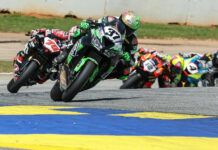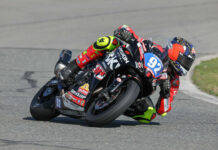Copyright 2003, Roadracing World Publishing, Inc.
FIRST PERSON/OPINION
Via e-mail:
Just a note about Greg White’s “Two Wheel Tuesday” programming that aired on Dec. 16 regarding the Dunlop tire test at Daytona.
Judging by the track conditions and the comments from the riders, taping was done on Monday or Tuesday, a full five to six days ahead of when the feature was aired on the 16th.
Greg, why did you not tell us about the tire failures, Jason’s crash or the stand that Mat Mladin has taken concerning the safety of the track or the tires? (thanks to RW and other websites for the daily info) Gee, do you think it means something when the defending series champion comments that he will not be back to compete unless some changes are made? I’m not a Mladin fan, however, I do expect honest journalism and what you gave us was pure bullshit from the tire companies and free ad from the bike manufacturers that were “team” segments…..get a clue, Greg, fans that follow the sport aren’t quite as stupid as you think.
Jeff Storjohann
Carroll, Iowa
The problem is not that the Superbikes have too much horsepower, but that they have a lot of horsepower combined with a lot more weight than a MotoGP bike. The weight of the bikes is the biggest problem combined with the speeds they can generate.
To race at Daytona, they need to at least put in an additional chicane to break up the run around the banking. This would limit the time on the banking and reduce the time that the tires are subjected to the heat buildup.
Ultimately, it would be better to have a couple of real corners put in the infield, starting where they would put in a chicane.
Daytona could do it if they wanted to, the question is do they want to and how many needed to get badly injured or killed before it is taken seriously enough by both Daytona and the AMA.
Paul Trautman
San Jose, California
I read the other reader comments posted on the RW webstite and I think the time has come to reconfigure Daytona to slow the bikes down REGARDLESS of whether Dunlop comes up with a tire that they think will work by the next test.
Nowhere else on the schedule do the bikes run a sustained 170+ like Daytona and in a day when a STOCK streetbike can go 180+ I don’t see any reason to demonstrate such high speeds. The skills needed to go high speed in a straight line (or around a bowl) are not nearly as exciting as the skills required to stop, turn and accelerate a bike.
More importantly, I don’t want to see a rider hitting a wall at 190. It would not be pretty! Further, even Airfence isn’t sufficient to buffer a wall at 170+ and we can’t get rid of the wall so we need to slow down when around the walls!
Kato didn’t die for nothing, did he?
George Leavell
Gilroy, California
The bottom line is, do we have to wait for someone to get killed before we modify the Daytona 200?
As soon as someone is seriously injured is too late! No one should have to fear for their life. This is suppose to be racing, as soon as one of the Honda riders have a problem then I’m sure something will happen, but again that will be too late. We don’t need this to happen for any rider, this is not good for the sport.
Carlos Hageleit
Vancouver, Canada
I believe that when one compares the speeds at which the new CBR1000RR went through the traps with the top speeds that Kocinski and company were hitting on the RC45 et. al. at 1997 and then the speeds of the 500cc 2-stroke GP bikes, one thing becomes alarmingly apparent:
Daytona itself as well as the majority of tracks on the AMA circuit are ill-suited to the power and speeds of the new Superbikes. Dunlop has a lot of explaining to do, indeed as did Michelin at the Brno leg of the 2002 MotoGP season when Rossi’s RC211V ate its rear tire. The difference is that we did not see commonplace recurrances.
The AMA needs to look at what Dunlop are doing, the state of American racetracks (appalling, Suzuka waiting to happen) and reconsider with respect to the safety of the riders and the preservation of the sport and its excitement. I am looking forward to the Honda vs. Suzuki war, the liter-bike chapter, and seeing the new 4-bangers wail and scream will be a big thrill. I just want to know that these chaps can race to their hearts’ content as safely as they can.
Ngoli Nyirenda
Coral Springs, Florida.
It wasn’t too long ago that you printed my letter about the 1000cc bikes being allowed, and now standard, in the Superbike class. After incidents like Miguel’s unfortunate injury at Loudon, a huge controversy sparked about all the walled tracks here in America. The riders agreed at that point that the machines had grown too fast for many of the tracks on the AMA calendar. Rightly so.
So what does everybody do? Increase displacement. Great for streetbikes…not so good for guys who get paid to put it all on the line, hoping not to put it into the wall. Instead of letting everyone bump up to the displacement of the Twins, the class should have put a 750cc displacement limit on the bikes. In response to the manufacturers, I still say it’s feasible to race a 750 and market a 1000. I guess we’ll never know.
Comparing tire performance in MotoGP and World Superbike to tire performance in AMA competition is not as easy as it sounds. Look at the tracks we’re running over here. Many of them are infields at oval tracks. Others have mixed concrete and asphalt surfaces. Others should have been resurfaced years ago. These are hardly hospitable environments for any tire, yet the manufacturers are trying like crazy to manufacture a product that will withstand the increased demands of the more powerful machinery under these very circumstances.
I don’t envy the job of the tire manufacturer or the rider who has to experience the limit of a tire under all these factors. But to just blame a motorcycle, rider, or tire brand for catastrophic failure is no longer enough. All factors need to be considered before pointing the proverbial “bony finger” at one cause or another.
Clint Fleckenstein
CRA #306
Bismarck, North Dakota
Since tire failures have occurred at tracks other than DIS, obviously there is an as-of-yet-unsolved problem with Dunlop tires. That being said, tire wear at Daytona has always been an issue going back as long as I remember to the Goodyear/TZ750 days. Even with the chicane leading into NASCAR Turn 3, there is still almost 2 miles of full-throttle top-gear racing around the facility including both 30-degree banked turns. This places a lot of heat into the center and left side of the tire. A change to the layout would seem to be in order, but the question becomes where and who pays? A series of wide, flat turns replacing the Speedway banking would certainly lower speeds, but DIS wouldn’t want to alter anything that could be construed as a safety issue to the NASCAR guys … same reason as there are no curbs on the existing chicane. I doubt either that they would want to pay what would be millions for the new pavement. Someone suggested a chicane in the runoff area coming out of NASCAR Turn 4 in the existing pit entrance lane. This would help as would yet another chicane on the exit of NASCAR turn 2 in existing paved runoff area. More Airfence would be needed for existing infield walls in both areas. If you add the chicanes, though, wouldn’t you spoil what has traditionally been a 200-mph gunfight? Just look at the joke most F-1 races have become. At one time, the Daytona 200 was the most important motorcycle race in the world. It isn’t now, and hasn’t been for a very long time. Unless changes to the layout can be made, in interest of rider safety but without spoiling close, competitive racing, perhaps it is time for The Powers That Be to abandon Daytona to the NASCAR guys. I don’t think the France family would shed a tear if the bikes never came back.
Craig Jackman
Ottawa, Canada
It is a sad fact of modern times that it’s going to take a serious injury or worse, the death of someone that’s well liked, before anything is done with regards to safety in AMA Pro Racing. NASCAR has acted the same way; it was only after the death of Dale Earnhardt that changes were made. Technically speaking, these are two different problems, but the root is in safety. With that in mind, is it not wise that changes should be made to improve safety when we know there is a problem that can readily be adressed?
Motorcycles have fallen out of favor with the general public because they were perceived as dangerous, what’s going to happen when someone gets dead at the Daytona 200? I bet you that’ll make national news, and it’s not the kind of news any of us want.
When I sit down with my friends to watch the 2004 Daytona 200 I don’t want to see any of these guys die when it’s very possible that failing tires can be avoided by either slowing the course down or (gulp) leaving the Daytona venue altogether. I understand we still race there because it’s part of tradition. But it must be said that the traditional way of doing business probably allowed a bunch of yahoos to test the bounce quotiant of civilian airliners on some larger buildings on the east coast a little over two years ago. [I’ll understand if you want to edit that last sentence out.]
Change the venue or slow things down at Daytona before someone gets hurt or dies. This is an avoidable situation. Even if AMA Pro is a separate part of AMA non-profit, the whole premise of both organizations is to do what’s good for motorcycling. The situation at hand is potentially very bad for motorcycling – change the track itself or leave the venue entirely.
Thomas Rubin
Rochester Hills, Michigan
Regarding the Dunlop tire explosions, I have a feeling that this problem will be taken care of in time for the big race in March. Dunlop will throw a ton of money at the problem, provide one (maybe two) tires that each team will have to use (if they want to live) and the race will go on.
Can’t wait to see what happens at Pikes Peak!
Scott Schneider
Bellport, New York
In addition to the tire failures listed in your recent news, I remember Anthony Gobert going for a wild ride on the Yamaha R7 Superbike at Daytona after his rear tire failed at high speed. I don’t remember the circumstances or if there was a determination of the cause of the failure.
Ken Pieschke
Cambridge, Ontario, Canada
I applaud Mladin’s stance re the tire issues at Daytona. He exhibits a degree of off-track leadership heretofore unseen… at least by me. I was particularly impressed by his comments in the 12.10 entry. There are no villians yet; DIS, the AMA, and Dunlop have all shown proper concern. That is step 1. The next step—-whatever it may be—-will show the player’s true colors.
Reg Kittrelle
Scotts Valley, California
It’s funny that all of a sudden the AMA is looking at how dangerous Daytona is AFTER the biggest tire supplier has problems with their slicks exploding. I didn’t hear any Michelin riders bitching about how scared they are of their tires. Daytona IS dangerous, has been for years. Just another example of how the AMA waits for somebody with big $$$ to bitch for them to recognize or even acknowledge a problem. It’s just too bad Michelin and the other tire manufacturers won’t get a chance to win the 200 due to a “PROBLEM” with the facility when in reality it’s Dunlop’s problem.
Rob Hunsinger
Mill Hall, Pennsylvania
I would just like to say that Mr. Trautman is absolutely correct in his assessment of the weight issue in the evaluation of the ‘tires ability to take the torture’ issue.
Also, you need to realize that the European circuits that GP bikes run on are very flowing and not nearly as ‘stop-n-go’-ish as the tracks in the USofA. Sure, the GP bikes make more power, but not that much more; superbikes (and supersport!) are based off of a street-designed motorcycle, GP bikes are racing-purpose-built machines that suffer no unnecessary weight. That additional weight is absolute torture on a bike that pumps out over 180 hp at the rear tire (and that’s just a privateer supersport bike).
I think the recommended ‘chicane solutions’ are very insightful and merit further investigation. Also, realize that this is just a problem; there is no need to freak out and start recommending abandonment of 1000cc bikes. With the focused attention of the AMA, the tire manufacturers, and the track owners this problem (like others before it) can and will be solved.
Professionally yours,
Kenton Russell
Professor, Washburn University
Topeka, Kansas
The latest post from Hollingsworth said, “Essentially it comes down to a balancing act between grip and wear…” This just doesn’t seem accurate. The Daytona race is the longest race of the season, so these tires should be able to last 25-30 laps, but this failure occurred in lap 11, one of which was a warm-up lap. So, this definitely wasn’t a worn tire that self-destructed. It sounds more like a major design problem. Also, DiSalvo’s comments were that there was no warning. Racers can tell during the end of the race if the tires are losing grip, soft, mushy, whatever you want to call it, there is some feedback from the tire that causes you to slowdown. Perhaps we will find out more information from other tire tests in January, but we cannot afford to see tire failure at 180-192 mph at any track.
Fred A. Ege
Elburn, Illinois
More Reader Comments On Dunlop Tires Exploding At Daytona
More Reader Comments On Dunlop Tires Exploding At Daytona
© 2003, Roadracing World Publishing, Inc.






